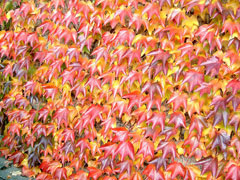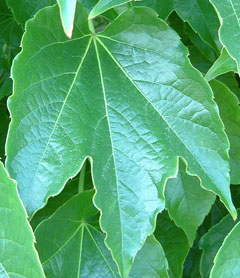 |
|
http://commons.wikimedia.org/wiki/User:Hedwig_Storch |
 |
| http://commons.wikimedia.org/wiki/User:Hedwig_Storch |
Translate this page:
Summary
Bloom Color: Green. Main Bloom Time: Early spring, Late spring, Mid spring. Form: Spreading or horizontal, Variable height, Variable spread.
Physical Characteristics

 Parthenocissus tricuspidata is a deciduous Climber growing to 18 m (59ft 1in) at a fast rate.
Parthenocissus tricuspidata is a deciduous Climber growing to 18 m (59ft 1in) at a fast rate.
See above for USDA hardiness. It is hardy to UK zone 4 and is not frost tender. It is in flower from July to August, and the seeds ripen from October to November. The species is hermaphrodite (has both male and female organs) and is pollinated by Insects.
Suitable for: light (sandy), medium (loamy) and heavy (clay) soils and prefers well-drained soil. Suitable pH: mildly acid, neutral and basic (mildly alkaline) soils. It can grow in semi-shade (light woodland) or no shade. It prefers moist soil.
UK Hardiness Map
US Hardiness Map
Synonyms
Ampelopsis tricuspidata. A. veitchii.
Plant Habitats
Woodland Garden Sunny Edge; Dappled Shade; Shady Edge; Ground Cover;
Edible Uses
Edible Parts: Sap
Edible Uses: Sweetener
Sap - sweet[177]. The sap flows quite freely when it is harvested in the spring, as the plant comes into new growth, and can be used as a sugar substitute[105].
References More on Edible Uses
Medicinal Uses
Plants For A Future can not take any responsibility for any adverse effects from the use of plants. Always seek advice from a professional before using a plant medicinally.
None known
References More on Medicinal Uses
The Bookshop: Edible Plant Books
Our Latest books on Perennial Plants For Food Forests and Permaculture Gardens in paperback or digital formats.

Edible Tropical Plants
Food Forest Plants for Hotter Conditions: 250+ Plants For Tropical Food Forests & Permaculture Gardens.
More

Edible Temperate Plants
Plants for Your Food Forest: 500 Plants for Temperate Food Forests & Permaculture Gardens.
More

More Books
PFAF have eight books available in paperback and digital formats. Browse the shop for more information.
Shop Now
Other Uses
This species can be grown as a ground cover plant in a sunny position[188]. Plants should be spaced about 2.5 metres apart each way[208]. They are very vigorous, however, and would soon swamp smaller plants[K].
Special Uses
Food Forest Ground cover
References More on Other Uses
Cultivation details
Landscape Uses:Arbor, Woodland garden. Requires a well-drained moisture retentive fertile soil[200]. Succeeds in any fertile soil in sun or part shade[202]. Dormant plants are hardy to about -15°c[200], though the young growth in spring can be damaged by late frosts. A very ornamental plant[1], there are several named varieties[182]. The flowers are only produced on mature stems[202] and plants usually only fruit after a long hot summer[219]. A rampant climbing plant, clinging by means of round pad-like suckers on the tendrils[11]. It can become a bit of a nuisance by growing into gutters[182]. Plants are very tolerant of trimming and can be cut right back to within 1 metre of the base if required to rejuvenate the plant[202]. Any pruning is best carried out in the spring[219]. Dislikes transplanting[11], plants often put on very little growth in the year after planting out, though they are then fast growing[202]. Plants often hybridize and so do not always come true from seed[200]. Special Features:
Not North American native, Invasive, Inconspicuous flowers or blooms.
References Carbon Farming Information and Carbon Sequestration Information
Temperature Converter
Type a value in the Celsius field to convert the value to Fahrenheit:
Fahrenheit:
The PFAF Bookshop
Plants For A Future have a number of books available in paperback and digital form. Book titles include Edible Plants, Edible Perennials, Edible Trees,Edible Shrubs, Woodland Gardening, and Temperate Food Forest Plants. Our new book is Food Forest Plants For Hotter Conditions (Tropical and Sub-Tropical).
Shop Now
Plant Propagation
Seed - best sown as soon as it is ripe in a cold frame[200]. Stored seed requires stratifying for 6 weeks at 5°c and should be sown as early in the year as possible[200]. Germination is variable. When they are large enough to handle, prick the seedlings out into individual pots and grow them on in the greenhouse for at least their first winter. Plant them out into their permanent positions in late spring or early summer, after the last expected frosts. Cuttings of half-ripe wood, 7 - 10cm taken at a node (ensure that it has at least 2 true buds), July/August in a frame[78]. Easy to root but they do not always survive the first winter[182]. Basal hardwood cuttings of current seasons growth, 10 - 12 cm long, autumn in a frame[200]. Layering[200].
Other Names
If available other names are mentioned here
Native Range
Coming Soon
Weed Potential
Right plant wrong place. We are currently updating this section.
Please note that a plant may be invasive in one area but may not in your area so it's worth checking.
Conservation Status
IUCN Red List of Threatened Plants Status :

Growth: S = slow M = medium F = fast. Soil: L = light (sandy) M = medium H = heavy (clay). pH: A = acid N = neutral B = basic (alkaline). Shade: F = full shade S = semi-shade N = no shade. Moisture: D = dry M = Moist We = wet Wa = water.
Now available:
Food Forest Plants for Mediterranean Conditions
350+ Perennial Plants For Mediterranean and Drier Food Forests and Permaculture Gardens.
[Paperback and eBook]
This is the third in Plants For A Future's series of plant guides for food forests tailored to
specific climate zones. Following volumes on temperate and tropical ecosystems, this book focuses
on species suited to Mediterranean conditions—regions with hot, dry summers and cool, wet winters,
often facing the added challenge of climate change.
Read More
Expert comment
Author
(Siebold.&Zucc.)Planch.
Botanical References
1158200
Links / References
For a list of references used on this page please go here
Readers comment
© 2010, Plants For A Future. Plants For A Future is a charitable company limited by guarantee, registered in England and Wales. Charity No. 1057719, Company No. 3204567.